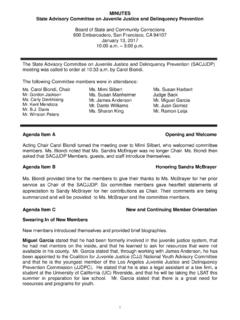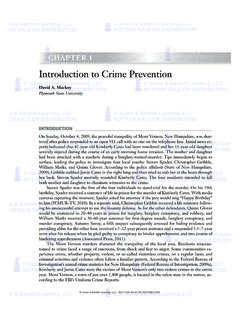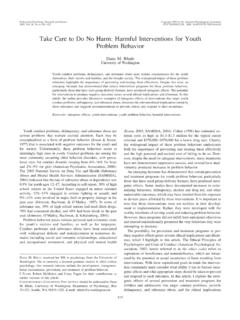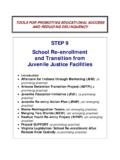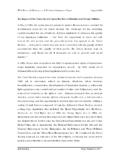Transcription of Truancy Prevention Efforts - www.promoteprevent.org
1 Truancy Prevention Efforts - 1 - Truancy Prevention Efforts in School-Community Partnerships February 2012 The emphasis that school districts place on regular school attendance is a reflection of the importance our nation places on education, as well as a recognition that being in school on a daily basis is necessary if education is to effectively prepare a child for adulthood. Truancy and chronic absenteeism, which are often steppingstones to dropping-out of school before graduation, have consequences for children, the adults these children will become, and the society in which they live. Programs that promote consistent attendance by addressing the risk factors that lead to Truancy can also improve academic achievement while reducing problem behaviors, including substance abuse and delinquency.
2 This brief will discuss: Definitions and extent of Truancy Risk factors Past approaches Effective approaches Examples of innovative approaches Economic consequences of Truancy Examples of Truancy reduction approaches from Safe Schools/Healthy Students sites Definitions and Extent of Truancy Every state requires that children attend school, or be provided with an authorized equivalent such as home schooling. These state mandates are accompanied by regulations on how state education and juvenile justice agencies must respond to Truancy ; however, the number of days absent and the criteria for categorizing unexcused absences under Truancy varies by jurisdiction. The following definitions capture the different categories of behaviors.
3 Definitions Truancy - While there is no nationally accepted definition of Truancy , the following definition reflects many state policies: If a student is absent without an excuse by the parent/guardian or if the student leaves school or a class without permission of the teacher or administrator in charge, it will be considered an unexcused absence and the student shall be considered truant (Seeley, 2006). National Center for Mental Health Promotion and Youth Violence Prevention - 2 - Habitual Truancy - Habitual Truancy is defined as a specific number of consecutive unexcused absences from school or a total number of unexcused absences over a semester or school year. The school is primarily responsible for responding to Truancy (often in the form of a call to parents).
4 If school Efforts fail, habitually truant students may become involved with the juvenile justice system (Seeley, 2006). Chronic Truancy - In recent years, many school districts have also created a third category, chronic truant. This term mainly refers to students who have been disciplined according to procedure after meeting the criteria for habitual Truancy , but continue to accumulate unlawful absences despite court or school mandate (Seeley, 2006). Chronic Absenteeism - Younger children are usually referred to as chronically absent rather than truant, because it is presumed that they cannot miss school without their parents knowledge. Young children (K 3) missing 10 percent or more of school each year are considered chronically absent (Chang & Romero, 2008).
5 Frequency of Truancy Reliable national or state data on Truancy are difficult to find. The No Child Left Behind (NCLB) Act required states to report Truancy rates by school beginning with the 2005 2006 school year, but due to the discrepancies in state definitions, aggregate national data are not available. However, some national data sets do give us an understanding of just how pervasive Truancy and chronic absenteeism are among students of various age groups: Based on a study by the National Center for Children and Poverty (NCCP), data from nine school districts across the nation demonstrated that over 11 percent of kindergartners were chronically absent. A five-year longitudinal study by NCCP found that nearly nine percent of first graders were chronically absent.
6 In addition, about 25 percent of kindergarteners were either at-risk ( , living below the federal poverty level, living with a mother who had not attended high school) or chronic absentees (NCCP, 2008). A study using data from a large national survey of drug use found that about 11 percent of eighth grade students and about 16 percent of 10th grade students reported having been truant at least once in the previous four weeks (Henry, 2007). Risk Factors and Consequences Related to Truancy Risk Factors The broad range of risk factors related to Truancy has important implications for programs and activities. A literature review commissioned by the Office of Juvenile Justice and Delinquency Prevention (OJJDP) found correlations between Truancy and four categories of risk factors: 1.
7 Family factors (lack of supervision; poverty; alcohol or drug abuse; lack of awareness of attendance laws; attitude toward education) National Center for Mental Health Promotion and Youth Violence Prevention - 3 - 2. School factors (school size; attitudes of students, staff, and teachers; inflexibility toward meeting different learning styles; inconsistent procedures for dealing with chronic Truancy ) 3. Economic factors (employed students; single parent homes; high mobility; parents with multiple jobs; lack of transportation) 4. Student factors (drug and alcohol abuse; lack of understanding of attendance laws; lack of social competence; mental and physical health problems) (Baker, Sigmon & Nugent, 2001). It should be noted that schools and communities are concerned about the effects of bullying on Truancy .
8 Although there is little evidence to suggest a strong direct linkage between bullying and Truancy , an OJJDP study found that if bullying results in the victim becoming less engaged in school, that victim is more likely to cease attending and achieving (Seeley, Tombari, Bennett & Dunkle, 2011). Among the many risk factors related to Truancy , for young children, family and economic factors have the greatest impact on chronic absenteeism in early elementary school. A national report by the NCCP (Romero & Lee, 2007) indicated that chronic absenteeism was highest among children living in poor families. This study also reported that children living with poor families in low-income communities are more likely to experience family risk factors compared to affluent children.
9 These risk factors may include having a mother with a low education or poor health, a mother who is unemployed, or the experience of food insecurity at home. Children experiencing multiple risk factors were more likely to miss 10 percent or more of the school year than their peers experiencing no such risks. Consequences of Chronic Absenteeism For young children, chronic absenteeism in early elementary school can lead to both short- and long-term consequences. Over 50 percent of those chronically absent in kindergarten were chronically absent in first grade (Romero & Lee, 2007). Early absenteeism affects school achievement in the early years, and this achievement gap has negative long-term effects, particularly for children living in urban, low-income communities.
10 Absence in early elementary school is associated with a seven percent lower probability of high school graduation (Seeley, 2008). Consequences of Truancy Overall, Truancy has a number of harmful consequences not only for students, but also for schools and communities. Truancy affects academic achievement throughout school. A literature review by the National Center for School Engagement (Heilbrunn, 2007) found that, compared to non-truant students, students who are truant: Have lower grades Need to repeat grades more often Have higher rates of expulsion Have lower rates of high school graduation. The review reported that some schools and districts still expel or otherwise push out students who are both truant and low-achieving.






